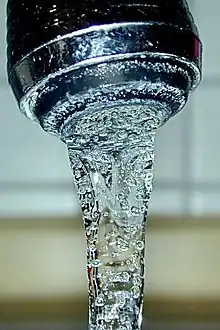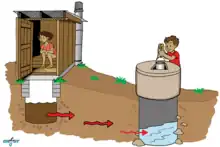Water
water safe for consumption
The quality and availability of drinking water vary between countries and regions. As a general rule, clean water is more difficult to get in hot weather, at low-income destinations and outside settlements.
- This article is about water as a consumable. See water sport for activities in bodies of water.

Understand
| “ | Water, water, everywhere nor any drop to drink |
” |
—from The Rime of the Ancient Mariner | ||
Tap water is often provided by the local government and treated to be at least relatively healthy for the local population. This may include filtering and adding chemicals. Tap water sourced from mountain springs may require little treatment and be of exceptionally high quality. However, water quality varies greatly between regions, and there are many countries where tap water, or at least unboiled tap water is dangerous to drink and can make you sick. One basic rule is to look at what the locals do: If they do not drink the tap water or do so only after boiling it, you should not drink water directly from the tap either.
Your body is accustomed to the water from your local environment. If you travel to a region with poor water quality from another with high water quality (or with different pathogens), then you may suffer from illness. Your body may adapt over time, but some water sources are so contaminated that it is unsafe to use them, lest you become infested with parasites or suffer other consequences.
Contamination
Biological contamination

- For more information on afflictions that can come from contaminated water, see the Enteric illnesses article.
- For more information on prevention and treatment of diarrhea, see the Travellers' diarrhea article.
Short-term ill effects of drinking water are usually down to contamination by micro-organisms. The commonest cause of travellers' diarrhea is viruses, but bacteria or protozoa can cause nearly identical symptoms. Longer-term effects can occur when parasites such as the eggs of parasitic worms are in the water supply. Those can infest your body for years if not discovered through a stool test and treated with deworming medicine.
Boiling, iodine treatment or filtering can mitigate the danger of illness, although toxins produced by some bacteria may remain despite the bacteria themselves being gone after the treatment. In a pinch, putting a clear bottle of water into the direct sunlight for a day or two will kill most pathogens by UV radiation. However, this is definitely not the safest way to purify water, as some pathogens, such as amoebas, are not killed by UV. Local health authorities may recommend some specific treatment, depending on the pathogens in the area.
Cyanobacteria in big concentrations ("algal bloom") can make water unhealthy to consume and irritating for the skin, if they produce toxins (which depends on species and circumstances). This is mainly a problem at some beaches, usually not a real hazard unless you have children or pets. Children might swallow water more easily and pets will try to clean their fur by licking. Both might enter water that adults would avoid.
Chemical contamination
In some countries, water supplies are prone to contamination by chemicals from industrial and agricultural sources. Although drinking such contaminated water is not recommended, it will generally not cause any immediate health issues if the contamination is at relatively low levels. If you drink such water over an extended period of time then long term health issues may arise. Note that water filters are unlikely to remove any of these chemicals. Another contaminant that can even occur in high income nations is lead. Plumbing used to be made from lead (plumbum in Latin) and some houses may still have lead tubes on the last few meters. This is usually no problem and those are increasingly being replaced, but if the chemical composition of the water changes, lead can leach into the water. Young children are especially susceptible to the health effects of lead exposure.
Quality by country or region
According to a 2014 infographic based on the United States CDC's recommendations, tap water is safe to drink in most of the EU and Western Europe, the United States, Canada, Greenland, Australia, New Zealand and a handful of Asian countries — elsewhere it isn't. This is a conservative recommendation, and there are many other countries with tap water that's potable, though in some it may upset your stomach at first while your body gets used to the local microbes and minerals.
For country-by-country information, see the "Stay healthy" section of each country article. In some countries, tap water may not even be safe for brushing your teeth.
Hard vs. soft water
You may hear locals refer to "hard" or "soft" water. The hardness of the water is determined by its mineral content, and there are stark regional variations owing to the various soils and rocks that water filters through before it reaches the mains supply. Water from different regions will likely vary in taste.
Hard water is not unhealthy to drink, but it can cause limescale build-up in appliances such as kettles and dishwashers, and require more detergent for dishes and laundry.
The ancient Romans preferred hard water, the evidence of which are the limescale deposits in erstwhile aqueducts that in some cases were large enough to be used by medieval masons for figurines.
Hot (boiling) water

One sometimes wants to have hot (near-boiling) drinking water, e.g. to make a cup of tea or other beverage. Availability of hot water at typical places of lodging and transportation varies around the world; it somewhat correlates with the nation's proclivity for tea-drinking.
- China – Very good. These days, hotel rooms tend to have electric kettles; in earlier times, the reception would have a battery of thermos bottles of hot boiled water (开水 kāishuǐ), and give them out to guests. Hot drinking water dispensers are nearly universally available at train stations, in airport terminals, and on trains.
- United Kingdom – Very good. An electric kettle plus a small supply of tea and coffee is ubiquitous, bordering on guaranteed, in hotel rooms and bed and breakfasts across the country; virtually all chain hotels will provide one for guest use, including budget chains such as Travelodge or Premier Inn (with some exceptions e.g. Marriott's Moxy brand).
- Vietnam – Medium. At many hotels/guest houses you can ask for boiling water (nước sôi), and the staff will get you a thermos bottle of it, or will let you use their electric kettle, but this is by no means guaranteed.
- Russia – Medium. At a hotel/guest house, ask for boiling water (кипяток kipyatok), and the staff may lend you an electric kettle, or show you how to use the kitchen, but this is not guaranteed. On long-distance trains, there is a water boiler in every car, but it may be in use only at certain times (when the car attendant decides to offer tea to passengers). While ordering tea (a tea bag and sugar) implies a fee, hot water is accessible for free.
- Latin America – Usually poor. If you ask for boiling water, the staff is more likely to offer to sell you a (small) cup of coffee. Bring your own portable heater (immersion coils) and use it in a suitable container.
Buy

If you find yourself somewhere where a trustworthy supply of water does not exist, you can:
- Use an international brand of bottled water (in some areas you should check that the bottle has not been refilled)
- Use a domestic brand of bottled water (cheaper, with quality as good as, or possibly much lower than the international brands)
- Boil the water before drinking (several minutes, depending on what you want to kill)
- Use iodine tablets (will kill bacteria, but make the water taste bad)
- Use a survival straw (probably best for extremely remote areas)
Consider drinking tea, beer, wine, soft drinks or bottled juices instead of water; these are usually safer. Milk or yoghurt may also be OK, but unpasteurized dairy products can transmit tuberculosis.
Stay healthy
| Note: Drinking the water is not the only hazard! If you rinse your toothbrush in tap water, or have a drink with ice cubes, or order a nice leafy salad in a restaurant that washes vegetables in contaminated water, then you may be exposed to whatever nasties are in the water. | |
Remember that polluted water can affect your health even if you don't drink it, if you use the water for such purposes as washing vegetables or brushing your teeth. See Precautions against disease in the Stay healthy article.
There are different ways of purifying water, some more effective against specific threats. In some areas boiling water for a minute is enough, in others, several minutes are needed. Filters vary in effectiveness, and should you have a concern, then you should consider buying your water in a sealed bottle from a reputable company.
Boiling the water or using iodine kills organisms but does not make chemically polluted water safe. You are unlikely to suffer in the short term from mildly chemically polluted water, but drinking it over an extended period could be harmful to your long-term health.
Even in areas that normally have safe drinking water, flooding and other incidents of contamination can take place. Any place with decent news or public health announcement coverage, and a reasonably responsible attitude on the part of relevant authorities, is likely to give warnings at times when it's necessary to boil or completely avoid drinking water that comes from sources that are safe under normal conditions.